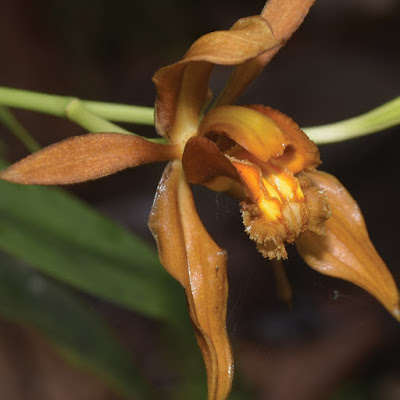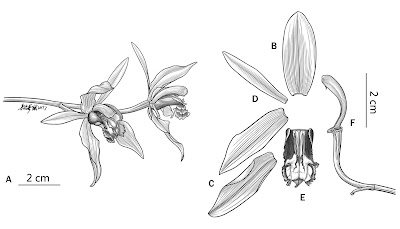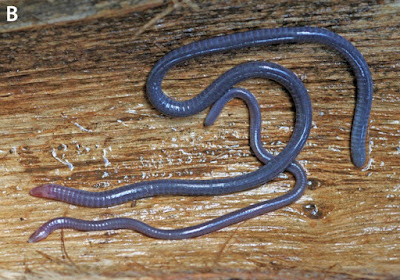[Most Recent Entries] [Calendar View]
Tuesday, July 4th, 2017
| Time | Event | ||||||
| 12:44a | [Botany • 2017] Coelogyne putaoensis • A New Species (Orchidaceae) from Myanmar Abstract Coelogyne putaoensis, a new species of section Ocellatae from Putao, Kachin State, Myanmar, is described and illustrated. It is morphologically similar to C. taronensis and C. weixiensis, presumably its nearest relatives. An identification key and colour photographs are provided. A preliminary risk-of-extinction assessment according to the IUCN Red List categories and criteria is given for the new species. Keywords: Arethuseae, Kachin, key, montane forest, section Ocellatae, taxonomy
Diagnosis: Coelogyne putaoensis is similar to C. taronensis and C. weixiensis, but can be distinguished by its solid yellowish brown sepals and petals, a brown lip with bright yellow markings, three keels extending from the base of the lip onto the mid-lobe, and lateral keels adorned with papillae. Type: MYANMAR. Kachin State: Putao Township, Hponkanrazi Wildlife Sanctuary, subtropical, evergreen, broad-leaved, montane forest, 2500–3100 m, epiphytic on tree trunks or lithophytic on rocks, 14 June 2016, Xiaohua Jin et al, PT-2116 (Holotype, PE!). Etymology: The new species is named after Putao, the northernmost town of Myanmar near which it was discovered in a vast area of unspoiled mountain forest. Distribution and habitat: Coelogyne putaoensis is a predominantly epiphytic species that grows on moss-covered branches and tree trunks, sometimes also on rocks, in humid, broad-leaved, evergreen, montane forest, from 2500 to 3100 m elevation. At present, C. putaoensis is only known from the type locality. Ye Lwin Aung, Xiaohua Jin and André Schuiteman. 2017. Coelogyne putaoensis (Orchidaceae), A New Species from Myanmar. PhytoKeys. 82: 27-34. DOI: 10.3897/phytokeys.82.13172 | ||||||
| 2:05p | [Herpetology • 2017] A Morphological and Molecular Study of Psilops, A Replacement Name for the Brazilian Microteiid Lizard Genus Psilophthalmus Rodrigues 1991 (Squamata, Gymnophthalmidae), with the Description of Two New Species
Abstract The lizard genus Psilophthalmus was originally described from the sandy deposits at the northern end of Serra do Espinhaço, in Santo Inácio, state of Bahia, but since then it has been recorded in other Brazilian localities of the states of Bahia, Minas Gerais, and Sergipe. Here, we review the collected specimens based on molecular markers (mitochondrial 12S, 16S, ND4 and cyt b, and nuclear C-mos and NT3) and morphological evidence (external, hemipenial and osteological morphologies). In the course of our revision we find out that Psilophthalmus Rodrigues 1991 was preoccupied by Psilophthalmus Szépligeti 1902 (Hymenoptera, Braconidae). The replacement name Psilops is proposed for the genus for which we recognize three species, with Psilops paeminosus as type species. One of the new species is found along the high elevation areas of the Chapada Diamantina plateaus, state of Bahia, while the other occurs in the cerrados of “Serra Geral”, in the occidental plateaus of that state. Psilops paeminosus comprises three distinct allopatric clades that, based on current evidence, cannot be diagnosed morphologically: one from the vicinities of the type locality, one from the lower São Francisco River, and a third from the uplands of Minas Gerais and southern inland Bahia. We keep the latter two as candidate species but defer their formal description until further evidence allows robust diagnosis. Derived clades of Psilops with shorter limbs have invaded hotter and drier environments, while mostly used sandy soils along their evolution. Keywords: Reptilia, Chapada Diamantina, Serra Geral, hemipenis, osteology, phylogeny, taxonomy Miguel Trefaut Rodrigues, Renato Recoder, Mauro Jr Teixeira, Juliana Gusson Roscito, Agustín Camacho Guerrero, Pedro M. Sales Nunes, et al. 2017. A Morphological and Molecular Study of Psilops, A Replacement Name for the Brazilian Microteiid Lizard Genus Psilophthalmus Rodrigues 1991 (Squamata, Gymnophthalmidae), with the Description of Two New Species. Zootaxa. 4286(4); 451–482. DOI: 10.11646/zootaxa.4286.4.1 | ||||||
| 2:26p | [Herpetology • 2017] Boulengerula spawlsi • A New Species of Boulengerula Tornier, 1896 (Gymnophiona: Herpelidae) from Kenya and the “Rediscovery” of Boulengerula denhardti
Abstract A new species of herpelid caecilian, Boulengerula spawlsi sp. nov., is described based on nine specimens from Ngaia (= Ngaya or Ngaja) Forest Reserve, Nyambene Hills, Meru County, Kenya collected between 2007 and 2013. The new species differs from all other Boulengerula in having more anteriorly positioned tentacular apertures and tentacular grooves that are partly or completely covered by the maxillopalatines. Specimens of the new species were previously erroneously reported as a rediscovery of the poorly known congener Boulengerula denhardti Neiden, 1912 together with a biogeographic scenario to explain their disjunct distribution that is not required. Keywords: Amphibia, Africa, biogeography, caecilians, morphology, systematics, taxonomy
Boulengerula spawlsi sp. nov. Boulengerula cf. denhardti Nieden, 1912: Loader et al. (2011: 6, figure 1) Boulengerula denhardti Nieden, 1912: Measey et al. (2012: 187–191, figure 1) Diagnosis. A Boulengerula that differs from all congeners in having the anterior part of the tentacular canal covered by maxillopalatine. It differs further from B. boulengeri Tornier, 1896 and B. denhardti in having inner mandibular teeth, from B. changamwensis Loveridge, 1932 and B. fisheri Nussbaum and Hinkel, 1994 in having a mainly darker blue or purple, rather than pink, body colour, and from all other Boulengerula (B. taitanus, Loveridge, 1935, B. niedeni Müller, Measey, Loader & Malonza, 2005, B. uluguruensis Barbour & Loveridge, 1928) in having more (> 150) annuli. Etymology. The species is named in honour of Stephen Spawls in recognition of his substantial contributions to African herpetology, including his discovery of this species of caecilian. Suggested English name. Spawls’ booleeMark Wilkinson, Patrick K. Malonza and Simon P. Loader. 2017. A New Species of Boulengerula Tornier, 1896 (Amphibia: Gymnophiona: Herpelidae) from Kenya and the “rediscovery” of Boulengerula denhardti. Zootaxa. 4286(4); 525–534. DOI: 10.11646/zootaxa.4286.4.5 |
| << Previous Day |
2017/07/04 [Calendar] |
Next Day >> |











